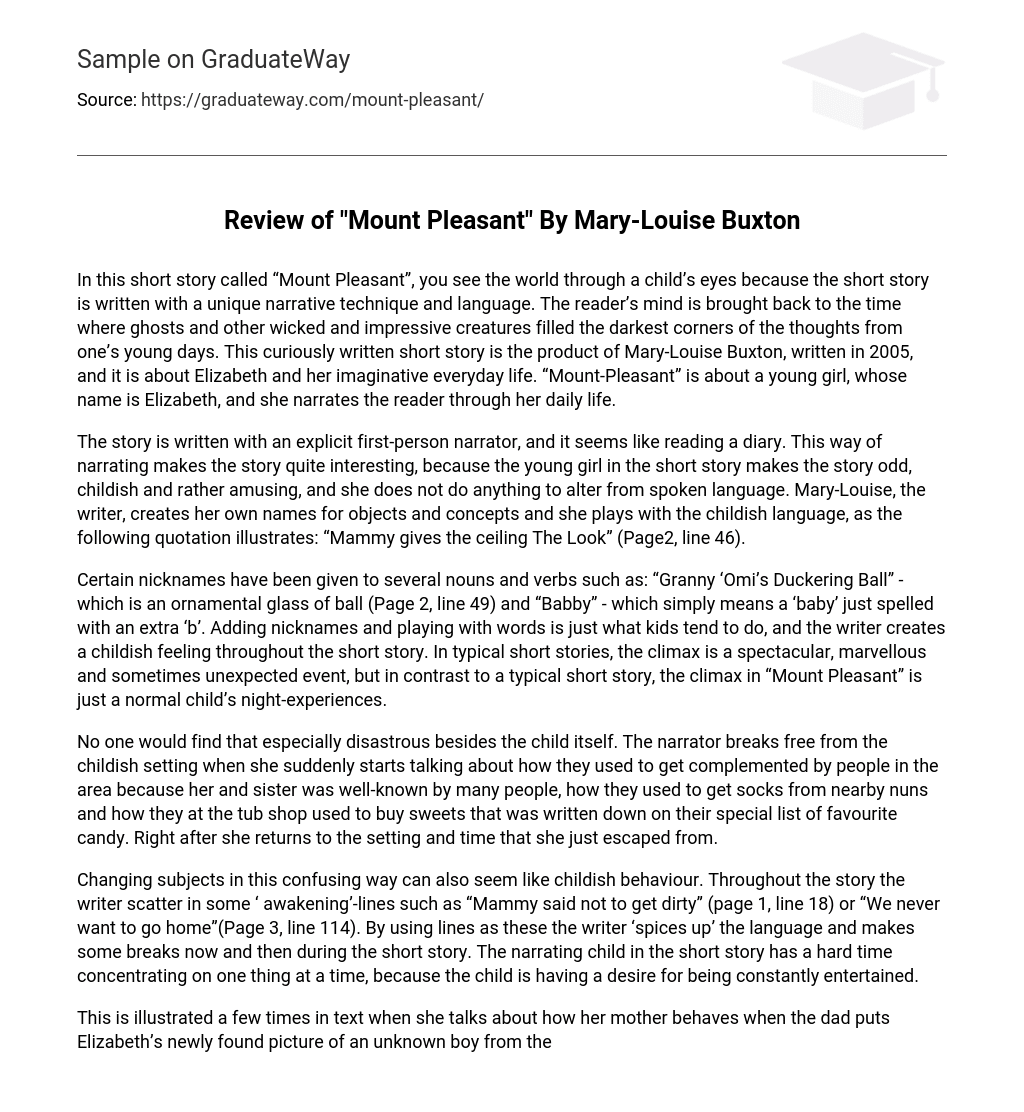In this short story titled “Mount Pleasant”, Mary-Louise Buxton takes the reader on a journey into the imaginative world of Elizabeth, a young girl. Published in 2005, the story employs a unique narrative technique and language that allow the reader to experience the world through a child’s eyes. Elizabeth’s everyday life is filled with ghosts, malicious creatures, and extraordinary beings that occupy her thoughts. Through her storytelling, readers are transported back to a time when these fantastical elements were present in every corner of her young mind.
In the story, the narrative is presented in a first-person perspective resembling a diary entry. This manner of storytelling adds intrigue to the tale by showcasing the distinctive and amusing nature of the young girl’s personality. Instead of utilizing formal language, the girl invents her own terms for various things. Mary-Louise, the author, endearingly employs childlike language throughout the story, exemplified by her quote: “Mammy gives the ceiling The Look” (Page2, line 46).
Certain nouns and verbs have been given nicknames, like the “Granny ‘Omi’s Duckering Ball” which refers to an ornamental glass ball (Page 2, line 49), and “Babby” which is simply a variation of the word “baby”. The writer incorporates these nicknames and playful language to create a sense of childishness throughout the short story. Unlike traditional short stories that often have a spectacular and unexpected climax, the climax in “Mount Pleasant” is a reflection of a normal child’s nighttime experiences.
No one, except the child, would consider it particularly disastrous. The narrator severs ties with the childish setting by abruptly discussing how they were praised by people in the community and how they received socks from nearby nuns. They also mention buying their favorite candies at the tub shop according to a special list. However, the narrator quickly returns to the current setting and time they had just escaped from.
The text highlights how changing subjects in a confusing manner can appear childish. The storyteller incorporates “awakening” lines such as “Mammy said not to get dirty” (page 1, line 18) or “We never want to go home” (Page 3, line 114). These lines add flavor to the language and create intermittent breaks within the short story. The child narrator struggles to focus on one thing at a time due to their constant need for entertainment.
The text repeatedly demonstrates this point by depicting the narrator’s mother’s reaction to her father displaying a photo of an unfamiliar boy on the fireplace mantel. Both parents play vital roles in the text. As seen through Elizabeth’s perspective, her mother is someone she must be cautious around, akin to a “Dangerous Foe.” It is not that she harbors hatred towards her mother; however, she must adhere to stringent rules that she finds unfavorable.
Elizabeth desires to engage in outdoor activities and have fun, similar to her older brother. Regrettably, her mother consistently forbids her from doing so because she wants Elizabeth to become a well-mannered and sophisticated young woman. On the other hand, Elizabeth’s father is more lenient with the children. In fact, he frequently communicates using language that resembles theirs, as evidenced by his statement: “Bobby Dazzler” (Page 3, Line 81).
The relationship between the mother and father in this short story brings together contrasting elements. Despite initial assumptions, they appear to be happy and loving. However, the father’s actions deviate from expectations of love. For instance, when confronted with their dog obstructing their path while carrying Elizabeth and her sister to their bedroom, he uses a newspaper to frighten it away. In a direct manner, he orders the dog to move, revealing a lack of respect and affection towards their pet (Page 4, line 133).
Throughout the story, there is a feeling of expectation that something bad will occur to the family, particularly Elizabeth. Nevertheless, as one reads on, it becomes apparent that their concerns were baseless and no harm befalls them. This prompts contemplation on whether appearances are truly accurate, which is emphasized by the mother’s actions near the conclusion of the tale. She discovers a picture of a man that Elizabeth had discovered earlier and returns it to its place on the mantelpiece. Elizabeth ponders if it had fallen during the night.
On page 5 line 164, Elizabeth recounts the moment when she placed the picture on the mantelpiece herself before going to bed. It is noteworthy that when Elizabeth showed the picture to her father, he suggested making it a part of their family by putting it on the mantelpiece alongside their photos. However, after this declaration, the picture is no longer found on the mantelpiece. This incident may explain the commotion experienced during the night, as Elizabeth’s shadow in the darkness could potentially be the ghostly presence of the man depicted in the picture.
Mary-Louise emphasizes the significance of the last line, as the act of placing the picture back on the mantelpiece holds great importance in the story. There are various ways to analyze and interpret this short story, as it is common for children narrators to perceive the world differently than adults. Short stories allow for a range of unexpected events, whether they be incredibly surreal or simply reflect a child’s nighttime behavior.





